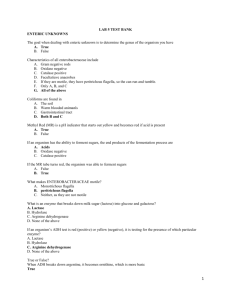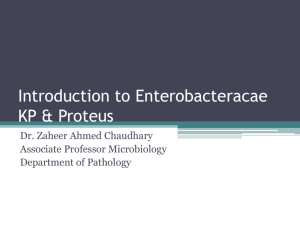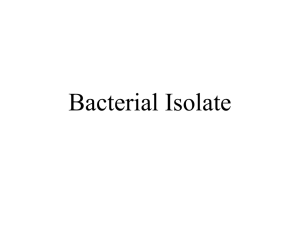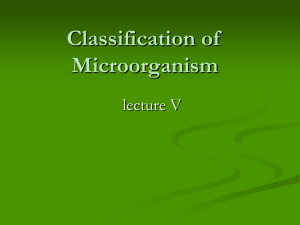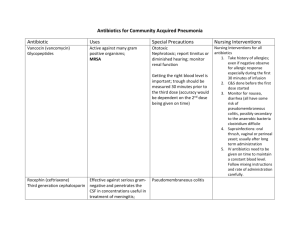TQ bank Lab Unit 2
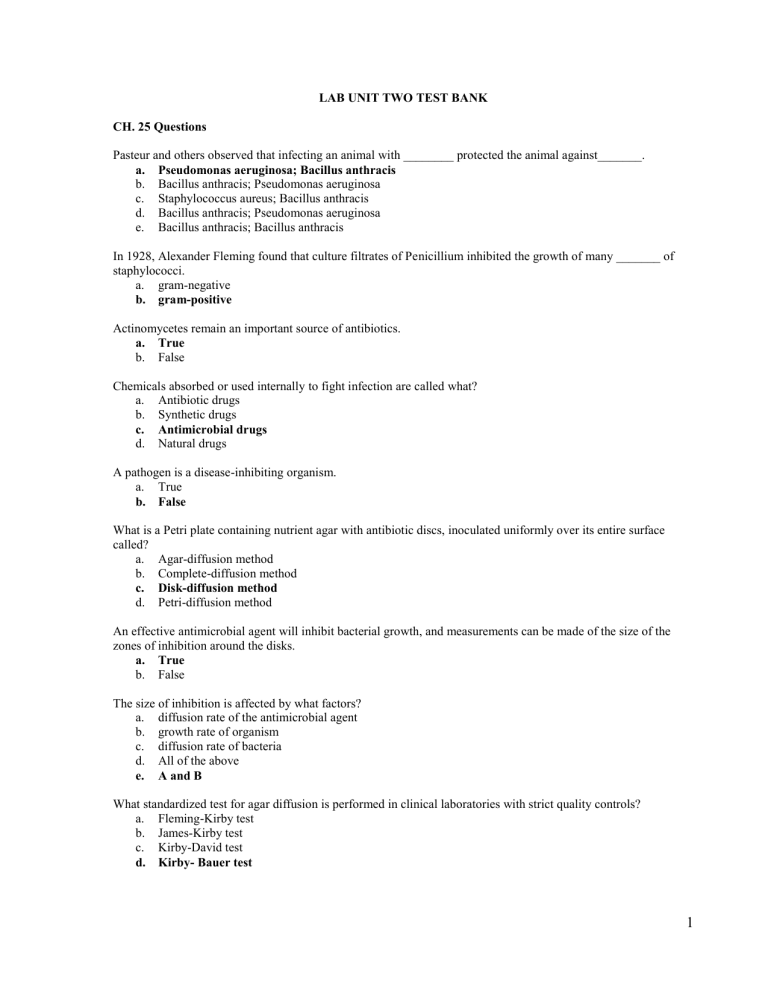
LAB UNIT TWO TEST BANK
CH. 25 Questions
Pasteur and others observed that infecting an animal with ________ protected the animal against_______. a.
Pseudomonas aeruginosa; Bacillus anthracis b.
Bacillus anthracis; Pseudomonas aeruginosa c.
Staphylococcus aureus; Bacillus anthracis d.
Bacillus anthracis; Pseudomonas aeruginosa e.
Bacillus anthracis; Bacillus anthracis
In 1928, Alexander Fleming found that culture filtrates of Penicillium inhibited the growth of many _______ of staphylococci. a.
gram-negative b.
gram-positive
Actinomycetes remain an important source of antibiotics. a.
True b.
False
Chemicals absorbed or used internally to fight infection are called what? a.
Antibiotic drugs b.
Synthetic drugs c.
Antimicrobial drugs d.
Natural drugs
A pathogen is a disease-inhibiting organism. a.
True b.
False
What is a Petri plate containing nutrient agar with antibiotic discs, inoculated uniformly over its entire surface called? a.
Agar-diffusion method b.
Complete-diffusion method c.
Disk-diffusion method d.
Petri-diffusion method
An effective antimicrobial agent will inhibit bacterial growth, and measurements can be made of the size of the zones of inhibition around the disks. a.
True b.
False
The size of inhibition is affected by what factors? a.
diffusion rate of the antimicrobial agent b.
growth rate of organism c.
diffusion rate of bacteria d.
All of the above e.
A and B
What standardized test for agar diffusion is performed in clinical laboratories with strict quality controls? a.
Fleming-Kirby test b.
James-Kirby test c.
Kirby-David test d.
Kirby- Bauer test
1
The minimum inhibitory concentration (MIC) of an antibiotic is determined by testing for bacterial growth in dilutions of the ______ in ______. a.
pathogen in nutrient agar b.
pathogen in blood agar c.
antibiotic in blood agar d.
antibiotic in nutrient agar
Who observed antibiosis around a Penicillium mold growth on a culture of staphylococci?
A.
Louis Pasteur
B.
Alexander Fleming
C.
Paul Ehrlich
D.
Robert Hook
In 1940, ___________ isolated the antibiotic streptomycin, produced by Actinomycetes.
A.
Alexander Fleming
B.
Louis Pasteur
C.
Selman A. Waksman
D.
Paul Ehrlich
Kirby-Bauer test uses Mueller-Hinton agar. T
Mueller-Hinton agar allows the antimicrobial agent to diffuse freely. T
The observation that some microbes inhibited the growth of others was made as early as
A.
1800
B.
1940
C.
1874
D.
1600
Chapter 45
What is secreted by the skin’s oil glands that inhibit bacterial growth?
A. water
B. sebum
C. salt
D. sugar
What contributes to creating the skin’s hypertonic environment?
A. water
B. sebum
C. salt
D. sugar
What are the normal microbes of the skin resistant to? a. Drying b. High salt concentrations c. water d. A and B
Where are transient microbes generally most present on the body?
A. Toes
B. Hands
C. Arms
D. All of the above
E. B and C only
2
What does Propionibacterium produce that maintains the pH of the skin?
A. ammonium
B. propionic acid
C. water
D. weak acids and bases
What pH level does the skin generally stay between? a. 1 and 2 b. 3 and 4 c. 3 and 5 d. 4 and 6
What is the most common type of bacteria found on the skin? a. Gram negative b. Gram positive c. Salt tolerant d. B and C
True or False.
Staphylococcus aureus is normally found on the skin and is considered an opportunistic pathogen. True
The skin is generally an inhospitable environment for most microorganisms. TRUE
Salts in perspiration create a hypotonic environment. FALSE (hypertonic)
Perspiration and sebum from the skin contribute to the environment of the normal microbiota of the skin. TRUE
Propionibacterium live in hair follicles. True
The epidermis is composed of what type of cells?
A) Keratin
B) Collagen
C) Elastic
D) A and B
Choose from the following microbes that are part of the normal microbiota of the skin.
A) Streptococcus
B) Staph. aureus
C) Propionibacterium
D) All of the above
E) A and B only
F) B and C only
Which agar is selective for salt-tolerant organisms?
A) Nutrient agar
B) EMB agar
C) Mannitol salt agar
How is mannitol salt agar differential?
A) Organisms that ferment mannitol will produce acid
B) Indicator will turn medium yellow.
C) Indicator will turn purple.
D) A and B
E) A and C
3
What enzyme(s) does S. aureus produce?
A) Catalase
B) Coagulase
C) Collagenase
D) Oxidase
E) All of the above
F) A and B only
G) A, B, and C only
What is the purpose of testing for the presence of coagulase?
A) Distinguish S. aureus from other species of Staphylococcus.
B) Distinguish S. aureus from proprionibacterium.
C) Distinguish Gram positive from Gram negative organisms.
D) All of the above.
What is an indicator of the presence of coagulase?
A) Clumping
B) No clumping
CHAPTER 46
Alpha-hemolysis is ____________________________________________.
A.
No hemolysis, and no change in the blood agar around the colony
B.
Green, cloudy zone around the colony. Partial destruction of RBC's
C.
Complete hemolysis, giving a clear zone with a clean edge around the colony
D.
All of the above
Beta-hemolysis is complete hemolysis, giving a clear zone with a clean edge around the colony.
True False
Gamma-hemolysis is no hemolysis and no change in the blood agar around the colony.
True False
The upper respiratory tract consists of the larynx and trachea.
True False
The lower respiratory tract consists of the nose and throat.
True False
Over 90% of streptococcal infections are caused by _________________.
A.
Streptococcus
B.
Neisseria
C.
Beta-hemolytic group A streptococci
D.
Haemophilus
What does the lower respiratory tract consist of?
A. bronchial tubes and alveoli
B. trachea, bronchial tubes, and alveoli
C. larynx, trachea, bronchial tubes, and alveoli
B. throat, larynx, trachea, bronchial tubes, and alveoli
C. nose, throat, larynx, trachea, bronchial tubes, and alveoli
Is the upper respiratory tract normally sterile?
A. Yes
4
B.
No
Is the lower respiratory tract normally sterile?
A. Yes
B. No
C. Depends on how polluted the air is
Is it normal to find Staphylococcus, Streptococcus, Neisseria, and Haemophilus living in the throat?
A. Yes
B. No
What are the predominant organisms in the throat cultures?
A. Staphylococcus
B.
Streptococcus
What are hemolysins produced by?
A. Staphylococcus
B.
Streptococcus
C. Both A and B
CHAPTER 51
What does IMViC stand for?
I indole production from breaking down tryptophan
M methyl red test for acid production from breaking down glucose
V Voges-Proskauer test for production of acetoin from breaking down glucose in the butanediol pathway
C for the use of citrate as a sole carbon source
What method(s) have been developed that provide a large number of results from one inoculation?
A: Rapid identification methods.
Why are systems developed to identify Enterobacteriaceae ?
A: To differentiate among the species contained within the two major groups of gram-negative organisms, known as the enterics (lactose fermenters) and the non-fermenters of lactose. Both groups are common causes of bacterial infections in humans.
Why is an oxidase test performed on a culture before using either an API 20E test strip or an Enterotube to identify the culture?
A: API 20E and Enterotube II are for the identification of oxidase- negative bacteria. If the oxidase test is positive, these two methods of identification would be useless.
Which of the following is TRUE regarding the BENEFITS of using the Enterotube? a.
You find out everything you need to know about your unknown b.
It provides quick results for a large number of tests from one inoculation c.
Motility results are provided and are visible with the tube
Which of the following results are NOT provided from the Enterotube? a.
Indole b.
Methyl red c.
Voges-Proskauer (VP) d.
Motility e.
citrate
5
The IMViC tests were developed as a means of ________ members of the Enterobacteriaceae, particularly the
_______, to determine if drinking water is contaminated with sewage. a.
Separating, coliforms b.
Combining; coliforms c.
Separating, pathogens d.
Combining; pathogens
Comparisons between rapid identification methods and conventional culture methods show that they are as accurate as ________________. a.
Conventional beaker methods b.
Conventional test-tube methods c.
Conventional agar methods d.
Conventional petri-dish methods
ANTIMICROBIALS
True or False.
The antibiotic with the largest zone of inhibition is the most effective one.
False
Just because one zone is the largest, does NOT mean that is the most effective antibiotic
True
What types of organisms do narrow spectrum antibiotics kill?
1.
Either Gram positive or Gram negative, but not both
2.
Always Gram negative only
3.
Always Gram positive only
4.
Both gram positive and gram negative
5.
Neither Gram positive or Gram negative
What types of organisms do broad spectrum antibiotics kill? a. Either Gram positive or Gram negative, but not both b. Always Gram negative only c. Always Gram positive only d. Both gram positive and gram negative e. Neither Gram positive or Gram negative
Why is it always good to be careful with broad spectrum antimicrobials? a. if there are a lot of gram negative bacteria, and you kill them, their endotoxins will be released in to the bloodstream and it could be fatal for the patient b. if there are a lot of gram positive bacteria, and you kill them, their endotoxins will be released in to the bloodstream and it could be fatal for the patient c. Both A and B are true
What is intermediate sensitivity of an antimicrobial drug?
A.
it implies clinical efficacy only in body sites where the drugs are physiologically concentrated
B.
it implies clinical efficacy only when higher than normal dose is used
C.
it implies clinical efficacy if given two drugs at a lower dosage
D.
it implies clinical efficacy if the patient is given drugs they are only slightly allergic to
E.
Both A and B
6
If a patient is allergic to the medication that needs to be prescribed for them, what is the next best option for their care?
A.
choosing two antibiotics in the intermediate sensitivity category
B.
choosing two antibiotics in the sensitive category
C.
choosing two antibiotics in the resistant category
D.
choosing one antibiotic in the intermediate category
What is the zone of inhibition?
A.
the zone on the inner part of the disc with little bacterial growth
B.
the zone that is clear around the disc, with no bacterial growth.
C.
the zone that is covered with bacterial growth
What does the zone of inhibition measure? a. the effectiveness of the antimicrobials only when checked against the Kirby-Bauer chart b. the effectiveness of the antimicrobials only pertaining to intermediate level antibiotics c. the effectiveness of the antimicrobials only pertaining to sensitive level antibiotics d. the effectiveness of the antimicrobials only pertaining to resistant level antibiotics
ENTERIC UNKNOWNS
The goal when dealing with enteric unknown is to determine the genus of the organism you have
A.
True
B.
False
Characteristics of all Enterobacteriaceae include
A.
Gram negative rods
B.
Oxidase negative
C.
Catalase positive
D.
Facultative anaerobes
E.
If they are motile, they have peritrichous flagella, so they can run and tumble.
F.
Only A, B, and C
G.
All of the above
Coliforms are found in
A.
The soil
B.
Warm blooded animals
C.
Gastrointestinal tract
D.
Both B and C
Methyl Red (MR) is a pH indicator that starts out yellow and becomes red if acid is present
A.
True
B.
False
If an organism has the ability to ferment sugars, the end products of the fermentation process are
A.
Acids
B.
Oxidase negative
C.
Catalase positive
If the MR tube turns red, the organism was able to ferment sugars
A.
False
B.
True
7
What is an enzyme that breaks down milk sugar (lactose) into glucose and galactose?
A. Lactase
B. Hydrolase
C. Arginine dehydrogenase
D. None of the above
Arginine, lysine & ornithine are all examples of what?
A. Enzymes
B. Proteins
C. Sugars
D. Amino Acids
When Arginine dehydrogenase breaks down argentine (an amino acid), it becomes ornithine (another amino acid), which is more basic.
A.
True
B.
False
If an organism has the enzyme ornithine decarboxylase, what is ornithine broken down into?
A.
Cadaverine
B.
Putrescine
C. Lysine
D. Ornithine dioxide
Phenol red, in the presence of ornithine, gets less red, although in the first 48 hours it may still be just orange.
A. True
B.
False
When an animal dies, the smell of “death” is usually attributed to what?
A. Putrefaction
B. There is breakdown of a lot of protein
C. If an organism has the enzyme lysine decarboxylase; it will take lysine and break off a carboxyl group to create cadaverine, which produces the cadaver smell.
D. All of the Above
Ornithine decarboxylase turns the media more _____1____, so phenol red turns ____2___.
A. 1-Basic, 2-Pink
B. 1-Acidic, 2-Red
C. 1-Basic, 2-Red
D. 1-Acidic, 2-Pink
If an organism can use citrate as its only carbon source, the medium will become ________ because acid is breaking down.
A.
Acidic (blue)
B.
Acidic (green)
C.
Basic (blue)
D.
Basic (green)
What is citrate?
A. A salt of citric acid
B. A part of the Krebs’s cycle
C. Orange food coloring
D. All of the above
E. Both A and B
8
When a medium contains iron and it turns black after inoculation with an organism
A.
Hydrogen sulfide has formed.
B.
Thiosulfate (the substrate) is reduced.
C.
The organism must be using sulfur as its terminal electron acceptor in the electron transport chain.
D.
All of the above
Urease is an enzyme that breaks down
A.
Particular sugars
B.
Particular proteins
Urease breaks urea down into
A.
Ammonia
B.
CO2
C.
Urine
D.
All of the above
E.
Both A and B only
Which of the following are true in terms of Urea test?
A.
The indicator is phenol red.
B.
Positive is pink, negative is yellow.
C.
Urea is made when proteins are broken down.
D.
The smell of OLD urine is from ammonia.
E.
All of the above
Tryptophan deaminase (TDA) tests for the presence of ___________.
A.
fat
B.
turkey
C.
pyruvic acid
D.
blood
In an Indole test, a red ring is positive.
TRUE :
To test for indole, add Kovac’s reagent.
TRUE :
A positive Voges-Proskauer test means the organism uses the butanediol fermentation pathway.
TRUE :
Voges-Proskauer test checks for the production of
A.
acetoin
B.
acetone
C.
acid
The gel test is to determine the presence of an enzyme that breaks down gelatin
A. False
B. True
What happens if the gelatinase enzyme is present?
A. Makes the gelatin solid
B. it breaks the gelatin down and liquefies it
If a sugar tubes turn yellow, what does this indicate?
A. The tube has acid, so the sugars were used (broken down) by the bacteria
B. The tube has no acid, so the sugars were used (broken down) by the bacteria
C. The tube has acid, so the sugars were not used (broken down) by the bacteria
D. The tube has no acid, so the sugars were not used (broken down) by the bacteria
What is fermentation?
A. Aerobic respiration
B. Anaerobic respiration
9
TSI medium contains .
A.
Three sugars
B.
Iron (Fe ++)
C.
Thiosulfate (oxidized sulfur)
D.
Phenol red (indicator where acids is yellow and basic is red)
E.
All of the above
When protein is digested, the pH becomes .
A.
Acid
B.
Base
C.
Amino acids
D.
Glucose
When sugar is fermented, the pH becomes .
A.
Acidic
B.
Basic
C.
Amino acid
D.
Glucose
A TSI slant that is all yellow is recorded as A/A. TRUE
A TSI slant that is red at the top and yellow at the butt is recorded as K/A. TRUE
A positive MRVP broth will be what color? a.
Red b.
Yellow c.
Blue d.
Green
A negative MRVP broth will be what color? a.
Red b.
Yellow c.
Blue d.
Green
True or false. In a litmus milk test, one must shake the tubes to mix the contents.
False
When does litmus change color? a. When oxidized b. It doesn’t c. When deoxidized d. All the time
What will be the color of litmus milk if the solution is acidic? a. Pink b. Purple c. Blue d. White
What will be the color of litmus milk if the solution is basic? a. Bluish b. Reddish c. Yellowish d. white
10
What color is a positive nitrate test? a. After adding the first two reagents, it turns red b. If there is no color change after adding the first two reagents, add zinc powder and it still does not turn red c. If there is no color change after adding the first two reagents, add zinc powder and it turns red d. Both A and B e. Both A and C
What is the enzyme that breaks down H
2
O
2
into H
2
0 and O
2
? a. Coagulase b. Oxidase c. Catalase d. Both A and B e. Both B and C
True or False.
If hydrogen peroxide is added and it bubbles the test is negative for catalase.
False
Methyl Red starts out yellow and becomes red when acid is present True
Phenol Red starts out red and becomes yellow when acid is present True
Phenol Red is used for media with a lower pH than Methyl Red True
What color would urea broth be if it produced ammonia (positive test)?
A.
Pink
B.
Clear
C.
Black
What color would urea broth be if it produced acid (negative test)?
A.
Yellow
B.
Clear
C.
Black
GRAM NEGATIVE ORGANISMS
When the color white is present in the Litmus milk test, what does it mean?
A.
Curds formed
B.
It fermented lactose and is acidic
C.
Litmus was reduced and became clear
D.
The casein protein in the milk was broken down.
When the color pink is present in the Litmus milk test, what does it mean?
A.
Curds formed
B.
It fermented lactose and is acidic
C.
Litmus was reduced and became clear
D.
the casein protein in the milk was broken down.
When the color blue is present in the Litmus milk test, what does it mean?
A.
Curds formed
B.
it fermented lactose and is acidic
C.
Litmus was reduced and became clear
D.
The pH is basic, so lactose was not fermented
What does the brown ring around the tube in the Litmus milk test mean?
A.
Gas in the curd
B.
Curds formed
C.
the pH is basic, so lactose was not fermented
D.
the casein protein in the milk was broken down(proteolysis)
11
Match the letter designations to their color results in the litmus milk test
White R
Pink A
Bluish K
Curds formed C
Gas formed G
Brown ring P
Motility Test: Which one is positive?
C
R
P
K
A
G
A.
Tube 1
B.
Tube 2
C.
Tube 3
D.
None of them
In Triple Sugar Iron (TSI) Slants, what does the A=?
A.
negative result
B.
gas formation
C.
Acid
D.
None of the above
In Triple Sugar Iron (TSI) Slants, what does the K=?
A.
Acid
B.
Sulfide
C.
Gas formation
D.
negative result
In Triple Sugar Iron (TSI) Slants, what does the G=?
A.
Acid
B.
gas formation
C.
negative result
D.
None of the above
In Triple Sugar Iron (TSI) Slants, what does the H2S=?
A.
Gas
B.
Positive result
C.
Negative result
D.
sulfur was used, iron was reduced to black color
What does Citrobacter freundii use as the source of carbon?
(A) Citrate
(B) Sodium phosphate
(C) Hydrogen
12
Where is Citrobacter freundii bacteria found?
A) Fomite
B) Soil
C) Water
D) Human intestine
E) Sandflies
F) B, C, D
G) B, C, D, E
H) All of the above
What infections do Citrobacter freundii cause?
A) Urinary Tract
B) Infant meningitis
C) Pneumonia
D) All of the above
E) A and B only
What is Escherichia Coli ( E. coli )?
A) Gram negative, rod shaped bacteria living in gut flora.
B) Gram positive, rod shaped bacteria living in gut flora.
C) Gram negative, spiral shaped bacteria living in gut flora.
D) Gram, positive, spiral shaped bacteria living in gut flora.
E. coli are able to sporulate (produce spores). FALSE
The best method to kill all E. coli bacteria is sterilization.
FALSE (Pasteurization or simple boiling are effective for their eradication).
Females can help prevent urinary tract infections (UTI) by wiping front to back and avoiding rough vaginal sexual intercourse. TRUE
What infection(s) are caused by E.coli
?
(A) Pneumonia
(B) Septicemia
(C) Meningitis
(D) Peritonitis
(E) All of the above
(F) A and B only
What antibiotic(s) is/are E. coli sensitive to?
(A) Streptomycin
(B) Gentamycin
(C) amoxicillin
(D) cephalosporin
(E) aminoglycosides
(F) All of the above
(G) A and B only
What do certain strains of E. coli, such as Escherichia coli O157:H7 produce?
A.
a toxin and can cause food poisoning
B.
produces nothing
C.
a toxin causing cancer
D.
None of the above
13
What is E. Coli Escherichia O157:H7 usually associated with?
A.
eating raw eggs
B. drinking spoiled milk
C.
eating cheese and contaminated milk
D.
All of the above
Contaminated cheese and meat, associated with Escherichia coli O157:H7 are usually contaminated during or shortly after slaughter or during storage or display.
A.
TRUE
B.
FALSE
What is the usual countermeasure for cooking suspect meat?
A. Microwave it first
B. don’t buy meat
C. cook it “well done”
D. None of the above
What is involved in careful inspection of slaughtering and butchering methods?
A. to make sure that the animal’s colon is removed and not punctured
B. buy organic
C. don’t buy meat
What is the strain of E. coli believed to be associated with the 2006 United States E. coli outbreak linked to fresh spinach?
A.
there was not an outbreak
B.
Escherichia coli O157:H7
C.
E. Colitis
D.
None of the above
Escherichia coli O157:H7 can be fatal particularly to young children, the elderly or the immunocompromised.
A.
TRUE
B.
FALSE
What contributes to antibiotic resistance?
A. Some of this is due to overuse of antibiotics in humans
B. some of it is due to the use of antibiotics as growth promoters in food animals
C. Patients stop taking their antibiotics before their bottle is empty
D. All of the above
E. A and B only
Enterobacter aerogenes is
A) A primary pathogen, causing illness in people with strong immune systems
B) An opportunistic pathogen, generally only causing disease in the immunocompromised
The most common site of infection from Enterobacter aerogenes is
A) Respiratory tract
B) Urinary tract
C) GI tract
D) All of the above
E) Both A and B only
Enterobacter, E. coli, and Klebsiella can be distinguished from other Gram negative rods by
A) Not being able to ferment lactose
B) Being a fast fermenter of lactose
14
Which all of the following describe Klebsiella pneumoniae?
A. non-motile
B. encapsulated
C. lactose- fermenting
D. facultative anaerobic
E. All of the above
Klebsiella pneumoniae is a normal flora of what areas?
A. mouth
B. skin
C. intestines
D. All of the above
Klebsiella pneumoniae naturally occurs in the soil?
A. True
B. false
Klebsiella pneumoniae can cause bacterial pneumonia, typically due to what?
A. Aspiration by alcoholics
B. being coughed on
C. inhalation of flatulence
D. None of the above
Klebsiella pneumoniae is most commonly implicated in what conditions?
A. Hospital-acquired urinary tract and wound infections, particularly in immunocompromised individuals
B. gardening
C. patient care nurses
D. schools, particularly in children
Klebsiella pneumoniae ranks second to what bacteria for urinary tract infections in older persons?
A. salmonella typhi
B. helicobacter pylori
C. Escherichia coli
D. vibrio cholerae
What is the most significant source of patient infection of Klebsiella pneumoniae?
A. soil
B. Feces
C. contaminated instruments
D. water/ food
Klebsiella pneumoniae is resistant to ampicillin but susceptible to what?
A. aminoglycosides
B. cephalosporins
C. Both aminoglycosides & cephalosporins
Which organism is responsible for many human urinary tract infections?
A.
Klebsiella pneumoniae
B.
Enterobacter
C.
Citrobacter freundii
D.
Proteus vulgaris
All Proteus vulgaris are motile
True False
15
Proteus species do not ferment _________, are oxidase _________, and urease _________.
A.
Fructose, positive, negative
B.
Lactose, positive, negative
C.
Fructose, negative, positive
D.
Lactose, negative, positive
Providencia stuartii is a non-motile
True False
Providencia stuartii is a __________ pathogen.
A.
Opportunisti c
B.
Obligate
C.
Non-motile
D.
All of the above
Strains of Providencia stuartii are sensitive to ampicillin.
True False
Providencia stuartii can cause urinary tract infections in patients with ______________________.
A.
Long term indwelling urinary catheters
B.
Extensive severe burns
C.
Both A & B are correct
D.
None of the above is true
What do the Salmonella organisms cause? Choose all that apply
A.
Rash
B.
Typhoid fever
C. foodborne illness
D. diarrhea
Salmonella species are _________________ and produce _________________.
A.
Non-motile, oxygen
B.
Motile, hydrogen sulfide
C. motile, gas
D. non-motile, hydrogen sulfide
True or false . Salmonella ferment lactose.
True or False. Food poisoning from Salmonella is usually from poultry and raw eggs and from food that has been cooked or frozen, and not eaten straight away.
True or False . The overuse of antibiotics in both the poultry and beef industries has stopped the spread of salmonella.
Which organism is NOT likely to transmit Salmonella to humans?
A.
Snake
B.
Turtle
C. gopher
D. iguana
True or False. The prevention of Salmonella as a food illness involves effective sanitizing of food contact surfaces.
What is an effective topical sanitizer against Salmonella?
A.
Alcohol
B.
Bleach
C.
Soap and water
D.
Antimicrobial soap
E.
Hydrogen peroxide
F.
Both A and B
16
Shigella Somnei is .
A.
Non motile
B.
Non spore forming
C.
H2S
D.
All of the above
The causative agent of human shigellosis is .
A.
Salmonella enterica
B.
Shigella somnei
C.
Providencia stuartii
D.
All of the above
Shigella infection is typically via fecal oral contamination. T
Ten bacterial cells can be enough to cause an infection.
T
The stool of Shigella infections contain
A.
Blood
B.
Mucus or Pus
C.
A and B
Shigella causes dysentery that result in the destruction of the epithelial cells of the intestine . T
Some strains of Shigella produce an enterotoxin similar to E.coli O157: H7. T
Serratia marcescens is a motile organism. True
S . marcescens is involved in nosocomial infections, particularly urinary tract and wound infections. True
S. marcescens prefers:
A. Damp conditions
B. Dry Conditions
C. Hot Conditions
What can cause complete eradication of the S. marcescens organism?
A.
Alcohol
B.
Bleach –based disinfectant
C.
Lysol
Where is S. marcescens commonly found?
A.
Respiratory and urinary tracts of adults
B.
The gastrointestinal system of children.
C.
All of the above
S. marcescens can cause
A. Conjunctivitis
B. Tear duct infections.
C. All of the above
Where is S. marcescens usually found in the restroom?
A.
In the grout of the tile
B.
On the sink
C.
In the trash
17


